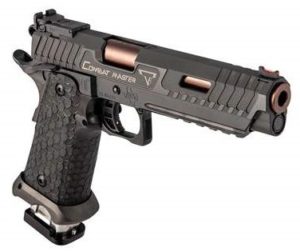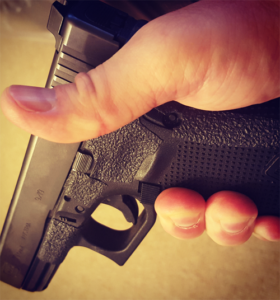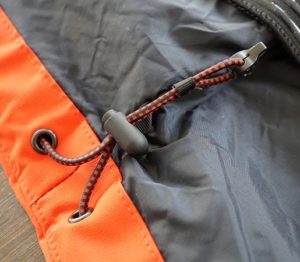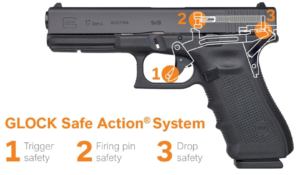An External Safety just Might be Your Best Choice.
Rick Molina
April 3, 2023 | 0 CommentsI really thought this one had been put to bed years ago but I just saw yet another rant about the evils of external safeties and how they will inevitably get you killed during the stress of a 3-second gunfight.

While the commentator was fair in acknowledging that some people can successfully "run and gun" with an external safety, and while many of his arguments about how striker-fired pistols (with no external safety) like the Glock, the Sig P320 and others can be carried safely, he reiterated several points that have been, and apparently continue to be, grossly misunderstood.
So here's my two-cents, which comes with the perspective of a pretty long run as a retailer, manufacturer and trainer for both law enforcement and civilians.
Myth #1: External Safeties Will Get You Killed.
Let's get the big one out of the way.
Under the stress of an attack, if you forget to flip your safety, that could get you killed.
True!
But if you forget to pull the trigger, that could get you killed too.
But that's ridiculous. No one would forget to pull the trigger.
Also, true! But why?
Because every time we practice shooting our gun... we pull the trigger. Have you ever seen someone go to the range and not pull the trigger? Some of us even spend a fair amount of time pulling the trigger when the gun is empty.
On the other hand, the typical concealed carry permit holder goes to a range, takes his gun out of its case (We'll talk about that in a minute.), sets it down on the bench, loads up a magazine, takes off the safety (because it's just a nuisance anyway), shoots for 30 minutes to an hour, unloads the gun, flips the safety back on, and puts the gun back in the case, where it sits for another 6 to 8 weeks.
So in one practice session, they pull the trigger 100 to 150 times and throw the safety once. An exaggeration? Not really. But let's say they throw the safety after each magazine. Fifteen-round magazines are common, so that means 7 to 10 throws of the safety.
Hang on. It gets worse.
These safety throws are rarely done as part of the draw sequence. The shooter picks up the gun, extends his or her arms, then gingerly takes off the safety, shoots, flips the safety back on and puts the gun down.
On the other hand, if you draw and throw the safety, shoot a 4 to 6 round string, then reset the safety and reholster - a 150-round session would give you 30 repetitions of manipulating the safety.
Most importantly, every single time you drew your gun, you also threw the safety. That builds muscle memory - the kind of muscle memory that makes releasing the safety part of your draw.

Oh and lets not forget that for combatives, best practice is to grab the pistol in the holster with a "high" thumb. So we're not asking you to do anything different with your grip.
So it turns out it's sloppy training that will get you killed - not an external safety.
Huh. Who'd a thought?
Myth 2: External Safeties Slow You Down.
At first blush, it sounds logical that asking you to do one more thing would take more time. But in a combatives draw stroke, we do several things concurrently. One of those things can be throwing the safety.
We throw the safety as we move the gun from the holster to our shooting position. And it doesn't matter which shooting position we're talking about - full retention, full extension or anywhere in between. You can't tell me it takes longer to move the tip of your thumb three-quarters of an inch, than it takes to move your arms 10 to 35 inches.
Keep in mind that many of world's fastest shooters got into the record books shooting a 1911 style gun, because external safeties were required in competitions.
And these speeds aren't unique to Max Michele.
Jerry Miculek, Robert Vogel, KC Eusebio, Jethro Dionisio, Doug Keonig, Taran Butler, Rob Leatham and a few thousand other shooters can handily throw a safety and still get their first shot off in well under a second. Hell, on a good day, with a couple dozen warm-up shots, I've even been known to hit a 0.99 now and then.
So the notion that an external safety will slow you down is just a load of crap being regurgitated by people who've never actually done what they're theorizing about.
Okay Rick, So you can make an external safety work. But why bother, since we have other options?
That is precisely the right question to ask. In the real world, people are the variable to consider. How often do you train? What combatives techniques do you know? What kind of shape are you in?
Look! I'm not suggesting that everyone should be carrying a gun with an external safety, I don't anymore. But there are plenty of people who should. And the one thing my colleague said, I take most issue with, is that external safeties may be okay for veteran shooters, but they're not for rookies.
It's the novice that is usually going to be safer with an external safety, not the veteran. An external safety is not a complexity that requires more expertise to master. It's a safeguard that protects inexperienced shooters from themselves.
- Most Americans don't practice enough to be reliable in how they manipulate a handgun.
How much should you practice? I can't tell you that through a blog. We'd need to train together to give you any meaningful advice. But I can tell you this. If you aren't practicing enough to remember to throw a safety, you aren't practicing enough to carry a gun on the street.
All you 2A trolls leaning into your keyboards to accuse me of attacking someone's rights to carry should know what I mean. No one has the right to endanger innocent bystanders because they don't want to practice with their gun. So pipe down!
- Most concealed carrying civilians don't have a proper holster.
It's surprising but true. Many people will get their CC permit, go to a gun store, drop 5 to 9 bills on a gun, but won't spend a 10th of that on a solid holster.
It's not about the money. It's cultural. In 2016, an NFL football player accidentally shot himself reaching in his gear bag looking for his wallet. His thumb hit the trigger and he died before the ambulance arrived.
People need to think of a holster as being just as much a part of the gun as a magazine is. If you carry, especially if you carry concealed, you need a proper holster - meaning one with a rigid shell that maintains an opening and preferably, one with at least enough friction retention to give an audible click that let's you know when the gun is fully seated.
- Many Americans can't safely holster a handgun.
Without a doubt, the most dangerous time for the shooter, during the firing sequence, is the reholster. A doctoral dissertation written by one of Gabe Suarez's students showed the two leading correlations to accidental, self-inflicted gunshot wounds are mental fatigue and reholstering.
The National Institutes of Health (NIH) say 2 out of 3 Americans are either overweight or obese. Any qualified instructor will teach you to "look your gun into the holster". You need to be able to visually ensure that nothing can engage with the trigger.
Many Americans can't do that.

You may have seen the YouTube video where a Police Chief shoots himself in the ass because he didn't visually clear the reholster. A draw cord on his jacket got in the trigger guard causing the gun to fire.
It was lucky that he was wearing a duty holster. What would have happened if he was carrying in the Appendix position?
He survived, but considering that was the 2nd time he'd shot himself, it didn't do his career much good.
The last two problems I just mentioned can be addressed with an external safety - and only with an external safety.
Engaging the safety before holstering (or "waistbanding") eliminates the danger of having a negligent discharge in the process. And no, internal safeties can't solve that problem.
Trigger Safeties are Useless
Now keep in mind I drank the Glock Kool-Aid a long time ago. So when I criticize my beloved Glock, there must be a damned good reason.

Most people don't understand the purpose of the trigger safety. They'll tell you it's to keep the trigger from moving unless your finger is properly positioned on the trigger.
NO!
It's damn near impossible to touch the trigger without disengaging the safety.
The trigger safety doesn't care if it's your finger, a draw cord, a tree branch, a cell phone wire or anything else. If something - anything - presses against the front of the trigger, the safety is going to move out of the way, and the gun is going to go bang.
To be completely accurate, the trigger safety would probably be better described as an "inertial" safety. Because the ONLY thing it does is keep the firing mechanism from working as a result of any acceleration or deceleration forces acting on the gun.
The specific purpose of the trigger safety is to keep the weight of the trigger from acting like a pendulum and swinging the firing mechanism into action if the gun is dropped (or shot backwards out of a cannon against a wall, I suppose).
They do nothing to protect against operator error or even mechanical failure at the connector.
More Choices. Not Less.
Having a gun with an external safety doesn't mean you have to use it.
The same way you can carry a double-action pistol with the hammer cocked, you can carry a gun that has an external safety without the safety being on.
There are three ways you can carry a gun that has an external safety.
Method #1: You can holster, carry and draw with the external safety on.
Method #2: You can holster with the external safety on, but carry and draw with it off.
Method #3: You can holster, carry and draw with the external safety off.
This is why I said external safeties are a valuable option for new CC permit holders.

We actually take newer shooters through the different methods. We start with Method #1. Then as they progress, develop trigger finger discipline, become consistent and gain confidence, we move them to Method #2.
If they reach a point where they want to go onto Method #3, then we take them out to get a Glock tattoo on their neck, and show them the secret handshake.
There is one final point I'd like to touch on regarding the issue of speed.
So we know that an external safety won't slow you down. With that said, effective combatives isn't about speed nearly as much as it's about timing and technique. That's to say focusing on when to move and how to move is more important than focusing exclusively on how fast you move.
In truth, sometimes the worst thing you can do is to rush to the gun. But that takes us squarely into a discussion about particular combative techniques that go far beyond what we can cover in the remainder of this article.
I wanted to mention this because timing and technique are critical parts of our training and because both will influence what your outcome might be, in the event of an attack.
Conclusion
This article wasn't intended to be argumentative. It is, however, meant to clear up some misinformation that could be detrimental to less experienced shooters who are still relying on the opinions of others to make certain decisions.
There's also a handful of decent training, safety and equipment tips in here that could help you advance your shooting skills more quickly.
Stay Safe! Every kind of Safe.

Rick Molina
